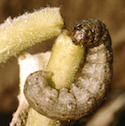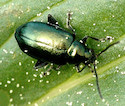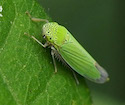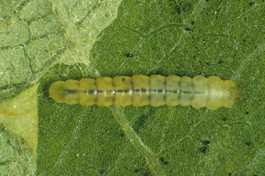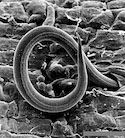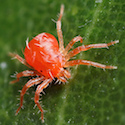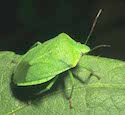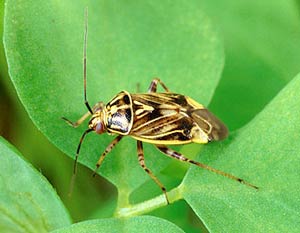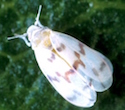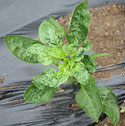By Dave DeWitt and Paul W. Bosland
Fiery Foods & BBQ Central Recommendations
Chile Pepper Bedding Plants… over 500 varieties from Cross Country Nurseries, shipping April to early June. Fresh pods ship September and early October. Go here
Chile Pepper Seeds… from all over the world from the Chile Pepper Institute. Go here
Insects and Other Pests
Insects are not usually a severe problem for peppers, but gardeners should watch for several that may appear. The insects most common to pepper plants are cutworms, aphids, pepper weevils, maggots, fleas beetles, hornworms, and leafminers. Early in the season, cutworms are the most damaging pests to both seeded and transplanted peppers. Seeded peppers are also subject to attack by flea beetles when the cotyledons emerge. Green peach aphids can become numerous at any time, but are probably more prevalent during the summer.
Besides the stress created by aphids feeding on plant sap, their honeydew gets on the fruit and leaves. Its presence on the leaves, if heavy enough, can decrease photosynthesis from sooty mold growth. Occasionally, loopers will feed on the foliage, exposing the pods to sunscald. Fall and beet armyworms, yellow-striped armyworms, and variegated cutworms may feed on pods. The beet armyworm will also feed on the foliage. The corn earworm feeds on pods and causes the pods to drop or become unmarketable. Problem insects differ in each region. To control the insect population, and keep seedlings insect-free, inspect the plants daily, weed well around the peppers, dispose of diseased plants immediately, and use insecticide if necessary.
Slight differences in preference may exist by the insects in the garden. For example, the Colorado potato beetle will feed on pepper, but it generally prefers the other Solanaceous vegetables, particularly potatoes and eggplants.
Following are descriptions of the insects and other pests which most commonly attack peppers.
Pest Descriptions
Cutworms
Description: Many species of cutworms exist; they are the larvae of a large family of moths. They are dull gray, brown, or black, and may be striped or spotted. They are stout, soft-bodied, smooth, and up to 1 1/4 inches long. When disturbed, they curl up tightly.
Damage: Cutworms attack only seedlings. They cut off the stems above, at, or just below the soil surface.
Control: Tilling disturbs the overwintering places of the cutworm. When setting out plants in spring, place cardboard, roofing paper, plastic, or metal collars around the young stems, and push the collar 1 inch into the ground to stop the cutworms. Treating the soil with Sevin before planting will also control cutworms.Green
Peach Aphids (Plant Lice)
Description: These aphids are usually light green and soft-bodied. They cluster on leaf undersides or on stems.
Damage: Aphids excrete a sticky liquid called honeydew, which creates spots on the foliage. A black fungus, sooty mold, may then grown on the honeydew. Severe infestations can cause wilting, stunting, curling, and leaf distortion.
Control: Usually, aphid predators and parasites keep the aphid numbers low, but the aphids can multiply quickly. Spray with insecticidal soap.
European Corn Borers
Description: Corn borer moths are active at night and hide during the day.
Damage: These larvae tunnel under the pepper pod calyx and feed inside the cavity. The borer is hatched from eggs deposited on peppers by the corn borer moth.
Control: Remove plant debris, especially cornstalks. The borer overwinters in corn stubble and emerges in the spring. Bacillus thuringiensis, rotenone, and Sevin are effective against the caterpillars.
Flea Beetles
Description: These black beetles are about 1/16 inch long.
Damage: Young plants are severely damaged and full of holes.
Control: Rotenone or Sevin dust is effective. The flea beetle is repelled by shade.
Fruitworms
Description: Fruitworms include the fall armyworm, beet armyworm, and tomato fruitworm (also called the corn earworm). At the larval stage, the worm is green, brown, or pink, with light strips along the sides and on the back. It grows to 1 3/4 inches long.
Damage: The fruitworm eats holes in fruits.
Control: Fruitworms can be removed by hand. Rotenone, Bacillus, or Sevin dust are also effective.
Grasshoppers
Description: Adults have front wings that are larger than the body and are held rooflike over the insect. The hind legs are long and adapted to jumping.
Damage: Grasshoppers eat pepper foliage. They may destroy complete plantings.
Control: Soil cultivation is useful because grasshoppers lay their eggs in the top 3 inches of soil. Birds often eat grasshoppers. Sevin dust is also effective.
Grubs
Description: Grubs are white to light yellow with dark brown heads. They are curved and 1/2 to 1 1/2 inches long. White grubs are the larvae of May beetles, live in the soil, and may take three years to mature.
Damage: The larvae feed on roots and underground parts.
Control: Till the soil repeatedly to uproot the grubs so the birds can eat them. )
Hornworms
Description: The larval stage of the sphinx moth, these large caterpillars have green body with diagonal lines on the sides and a prominent horn on the rear end. They can be up to four inches long.
Damage: They ravenously eat foliage and can strip a pepper plant, killing it.
Control: Hornworms are large enough to be removed by hand. However, rotenone, Bacillus, or Sevin dust is effective.
Leafhoppers
Description: They are usually green, wedge-shaped, and up to 1/8 inch long. They fly quickly when disturbed. Nymphs resemble the adults, but are smaller.
Damage: The leafhopper spreads curly top virus and can cause hopperburn. Hopperburn is rare in pepper, but the symptoms are tips and sides of pepper leaves turning yellow to brown and becoming brittle.
Control: Remove infested plants or plant parts immediately. Pyrethrum or Sevin dust is effective.
Leaf Miners
Description: The larva is yellow, about 1/8 inch long, and lives inside the leaves. The adult is a tiny, black and yellow fly.
Damage: The infected leaves are blotchy. The larvae make long, slender, winding mines under the epidermis of the leaves.
Control: Remove infested leaves. Sabadilla dust will also control leaf miners.
Pepper Maggots
Description: The maggot is the larva of a fly. It is white or yellowish white, and about 1/4 to 1/2 inch long. Adult flies are yellow-striped flies about 1/4 inch long with dark bars on the wings.
Damage: Maggots eat the core of the pepper pod, causing it to decay or drop from the plant.
Control: Rotenone or malathion is effective.
Pepper Weevils
Description: Black weevils are sparsely covered with gray or tan hairs. Larvae are white with brown heads.
Damage: The grub and the adult weevil cause damage. The grub feeds on blossom buds and the pods. The adult feeds on leaves, blossom buds, and pods. Larvae feed inside the fruit. Weevil larvae and excrement are left in the pepper fruit.
Control: Destroy crop residue and weeds of the nightshade group to reduce the possibility of adult weevils overwintering. Plants should be dusted or sprayed weekly with Sevin or diatomaceous earth.
Root-Knot Nematodes
Description: Nematodes are microscopic worms that feed on the plant roots. Three species of root-knot nematodes cause serious damage to peppers, Meloidogyne incognita, M. hapla, and M. arenaria.
Symptoms: Above-ground symptoms include plant stunting and leaf wilting. Roots infected with root-knot nematodes have obvious swellings or galls. Injury is more severe in sandy soils.
Control: Use resistant cultivars, crop rotation, and/or soil fumigants.
Slugs and Snails
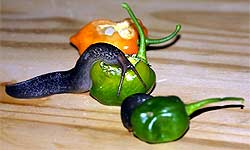
Description: Snails differ from slugs in that snails have shells.
Damage: Plant parts are missing, and a shiny trail from the pest is left on the plant or ground.
Control: Slugs and snails can be trapped under boards. Pans of fresh beer can be placed in the garden to attract and kill the pest. Chemical bait (metaldehyde) is also available.
Spider Mites
Description: Spider mites are red arachnids almost too small to be seen with the naked eye. If the infestation is high, the underside of leaves will have webs on them.
Damage: Leaves curl downwards (inverted spoon). A bronzed or russeted appearance on leaves or fruits occur. They can kill the plant if left uncontrolled.
Control: In the early stages, these mites can be eliminated by washing the plant with a mild soap solution, then spraying the plant with water, including the undersides of leaves where the mites usually harbor. Repeat this process weekly until the mites are gone. If the mite problem is very severe, a miticide can be sprayed.
Stink Bugs
Description: Stink bugs are greem, blocky insects about 1/2 inch long. Both the nymphs and adults damage plants.
Damage: Fruits have a cloudy spot, whitish area with indistinct borders. Damage is similar to hail damage on fruit, but hail damage tears leaves.
Control: Sabadilla dust or sevin.
Tarnished Plant Bugs
Description: These insects have a greenish-yellow to brown body 1/4 inch long. There are yellow, brown, and black markings on the body. There is a yellow tinge at the end of each fore wing.
Damage: They inject a toxin when feeding on blossoms and buds, causing them to drop.
Control: Sabadilla dust.
Thrips
Description: Thrips are extremely small (.04-.06 inch long) winged insects that suck sap from plants. They can produce a new generation every two weeks.
Damage: Leaves are distorted and curl upward (boat-shaped). The lower surface of the leaves develops a silvery sheen that later turns bronze.
Control: Malathion, sulfur, and diatomaceous earth are effective.
Whiteflies
Description: Whiteflies are harmful because they fly from one plant to another and quickly attack all peppers. They can also carry viruses to plants. These pests are white and about 1/16 inch long.
Damage: Adult and young whiteflies feed on the underside of leaves. They suck the juices from the leaves, causing the leaves to shrivel, turn yellow, and drop.
Control: Rid the area of the infested plant that harbors the whiteflies. Soap solutions can be sprayed on the plant. Aerosol insecticides used for other flies will kill airborne whiteflies.
Abiotic Disorders
Blossom-End Rot
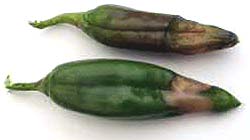
Causal agents: Blossom-end rot occurs when the plant is unable to take up adequate calcium, a condition caused by fluctuating soil moisture (drought or overwatering), high nitrogen fertilization, or root pruning during cultivation. Wilting, lack of soil moisture, and lack of calcium encourage the problem.
Symptoms: This disorder first appears as a water-soaked area. The tissue near the blossom end of pods have a brown discoloration. Spots elongate and become brown to black, dry and leathery. Discolored tissue shrinks until the affected area is flat or concave. Blemishes range from 1/4-inch spots to 3-inch-long elongated spots. Pods affected with blossom-end rot usually ripen prematurely. Fungi growing on and within the infected pods is common. The fungi, however, are not the cause of the initial problem.
Control: Maintain a uniform supply of soil moisture through irrigation and avoid large amounts of nitrogen fertilizer. If manure is applied, turn it under in the fall (as early as possible) so it will be well rotted before planting time. Irrigate when necessary during rapid pod development. Some sources suggest adding calcium chloride to the soil to boost calcium, but we discourage this practice in the Southwest, where the soils usually have too many salts.
Herbicide Injury
Symptoms: A hormone-type herbicide, such as 2,4-D (Weed-B-Gon) can cause distorted leaves. Other herbicides may cause chlorosis, necrosis, or lesions.
Control: Control spray drift of herbicide application or simply avoid using herbicides near pepper gardens.Mutations
Symptoms: Symptoms include leaf distortion, variegation in leaves, and fruit deformity. Mutations can be mistaken for herbicide damage or viral infection.
Control: No control is necessary, but the pods of interesting mutants should be sent to the Capsicum Genetics Cooperative, Box 30003, Dept. 3Q, NMSU, Las Cruces, NM 88003.
Pod Drop
Symptoms: Immature pods drop off the plant. This condition is caused by excessive nitrogen, heat stress, or insufficient water.
Control: Avoid overfertilizing and underwatering. When the condition is corrected, the plant will resume flowering and fruiting.
Salt Problems
Symptoms: Young seedlings are “pinched off” at the soil line from heavy amounts of salt in that area. A young seedling can die when light rains move the salt to the young, tender roots.
Control: Control salt problems by avoiding planting in fields with severe salt problems. Irrigate heavily prior to planting so that the salt is moved below root areas.
Sunscald
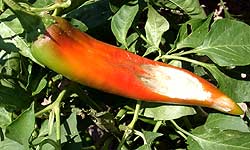
Causal agent: Sunlight causes the problem. Interestingly enough, the smaller-podded varieties with erect fruits are not as susceptible to sunscald as are the large-podded varieties, such as Bells and New Mexicans. Mature green fruits are the most sensitive.
Symptoms: A necrotic or whitish area on the fruit, on the side exposed to afternoon sun. Often fungi, such as Alternaria spp., grow on affected area of pods.
Control: Keep pods shaded by the plant’s leaves or by screening. Harvest the fruits carefully, and avoid stress to the plant from water, nitrogen, or nematodes.
Wind Injury
Symptoms: In most cases, pepper plants can withstand strong winds without significant injury. However, some larger plants may snap off at the soil line, where callus tissue has formed from wind whipping the plant back and forth in hard, crusty soil.
Control: Control the injury by erecting wind screens.
Excerpted from The Pepper Garden, published by Ten Speed Press in 1993.






